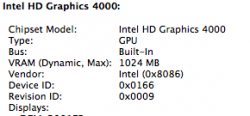
OS X 10.9.3, released last week, boosted the maximum VRAM used by the Intel HD 5000/5100/5200 graphics chips used in the most recent 2013/2014 MacBook Airs and Retina MacBook Pros.
First noticed by French site Mac4Ever [Google Translation], updating to 10.9.3 increases available VRAM from 1024MB to 1536MB, boosting the size of the shared memory, possibly to further improve 4K performance on certain machines.

The 10.9.3 update, available via the software update tool in the Mac App Store, also included enhanced support for 4K displays and restored the ability to sync contacts and calendars between Macs and iOS devices over USB.
Update 12:45 PM PT: As noted by forum member SmileyDude, some machines with HD 4000 graphics have seen a VRAM boost as well, namely the 2012 Mac Mini, which now has a maximum VRAM of 1024MB, up from 768MB.
(Thanks, Peter!)
Article Link: OS X 10.9.3 Boosts Maximum VRAM of Recent Retina MacBook Pro and MacBook Air Models


